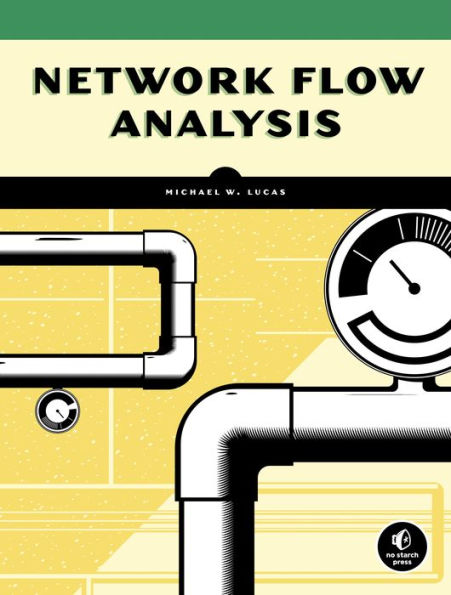You know that servers have log files and performance measuring tools and that traditional network devices have LEDs that blink when a port does something. You may have tools that tell you how busy an interface is, but mostly a network device is a black box. Network Flow Analysis opens that black box, demonstrating how to use industry-standard software and your existing hardware to assess, analyze, and debug your network.
Unlike packet sniffers that require you to reproduce network problems in order to analyze them, flow analysis lets you turn back time as you analyze your network. You'll learn how to use open source software to build a flow-based network awareness system and how to use network analysis and auditing to address problems and improve network reliability. You'll also learn how to use a flow analysis system; collect flow records; view, filter, and report flows; present flow records graphically; and use flow records to proactively improve your network. Network Flow Analysis will show you how to:
–Identify network, server, router, and firewall problems before they become critical
–Find defective and misconfigured software
–Quickly find virus-spewing machines, even if they’re on a different continent
–Determine whether your problem stems from the network or a server
–Automatically graph the most useful data
And much more. Stop asking your users to reproduce problems. Network Flow Analysis gives you the tools and real-world examples you need to effectively analyze your network flow data. Now you can determine what the network problem is long before your customers report it, and you can make that silly phone stop ringing.
"1100390165"
Unlike packet sniffers that require you to reproduce network problems in order to analyze them, flow analysis lets you turn back time as you analyze your network. You'll learn how to use open source software to build a flow-based network awareness system and how to use network analysis and auditing to address problems and improve network reliability. You'll also learn how to use a flow analysis system; collect flow records; view, filter, and report flows; present flow records graphically; and use flow records to proactively improve your network. Network Flow Analysis will show you how to:
–Identify network, server, router, and firewall problems before they become critical
–Find defective and misconfigured software
–Quickly find virus-spewing machines, even if they’re on a different continent
–Determine whether your problem stems from the network or a server
–Automatically graph the most useful data
And much more. Stop asking your users to reproduce problems. Network Flow Analysis gives you the tools and real-world examples you need to effectively analyze your network flow data. Now you can determine what the network problem is long before your customers report it, and you can make that silly phone stop ringing.
Network Flow Analysis
You know that servers have log files and performance measuring tools and that traditional network devices have LEDs that blink when a port does something. You may have tools that tell you how busy an interface is, but mostly a network device is a black box. Network Flow Analysis opens that black box, demonstrating how to use industry-standard software and your existing hardware to assess, analyze, and debug your network.
Unlike packet sniffers that require you to reproduce network problems in order to analyze them, flow analysis lets you turn back time as you analyze your network. You'll learn how to use open source software to build a flow-based network awareness system and how to use network analysis and auditing to address problems and improve network reliability. You'll also learn how to use a flow analysis system; collect flow records; view, filter, and report flows; present flow records graphically; and use flow records to proactively improve your network. Network Flow Analysis will show you how to:
–Identify network, server, router, and firewall problems before they become critical
–Find defective and misconfigured software
–Quickly find virus-spewing machines, even if they’re on a different continent
–Determine whether your problem stems from the network or a server
–Automatically graph the most useful data
And much more. Stop asking your users to reproduce problems. Network Flow Analysis gives you the tools and real-world examples you need to effectively analyze your network flow data. Now you can determine what the network problem is long before your customers report it, and you can make that silly phone stop ringing.
Unlike packet sniffers that require you to reproduce network problems in order to analyze them, flow analysis lets you turn back time as you analyze your network. You'll learn how to use open source software to build a flow-based network awareness system and how to use network analysis and auditing to address problems and improve network reliability. You'll also learn how to use a flow analysis system; collect flow records; view, filter, and report flows; present flow records graphically; and use flow records to proactively improve your network. Network Flow Analysis will show you how to:
–Identify network, server, router, and firewall problems before they become critical
–Find defective and misconfigured software
–Quickly find virus-spewing machines, even if they’re on a different continent
–Determine whether your problem stems from the network or a server
–Automatically graph the most useful data
And much more. Stop asking your users to reproduce problems. Network Flow Analysis gives you the tools and real-world examples you need to effectively analyze your network flow data. Now you can determine what the network problem is long before your customers report it, and you can make that silly phone stop ringing.
23.99
In Stock
5
1

Network Flow Analysis
224
Network Flow Analysis
224Related collections and offers
23.99
In Stock

Product Details
| ISBN-13: | 9781593273002 |
|---|---|
| Publisher: | No Starch Press |
| Publication date: | 06/01/2010 |
| Sold by: | Penguin Random House Publisher Services |
| Format: | eBook |
| Pages: | 224 |
| File size: | 1 MB |
About the Author
From the B&N Reads Blog
